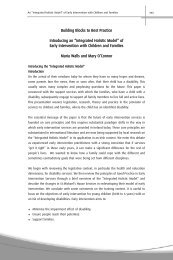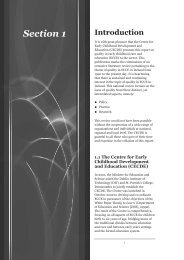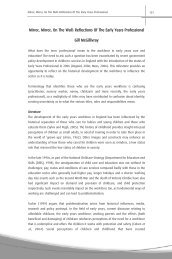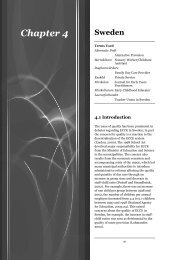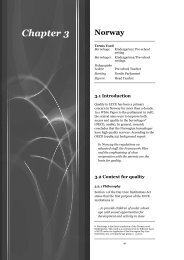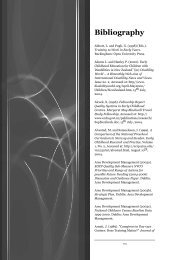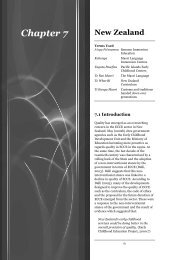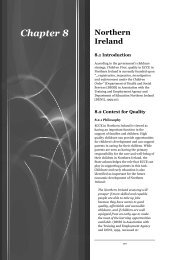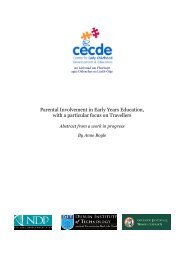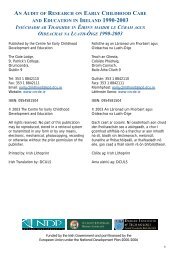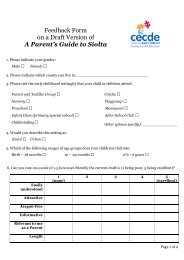Policy Developments 1990-2004 - Centre for Early Childhood ...
Policy Developments 1990-2004 - Centre for Early Childhood ...
Policy Developments 1990-2004 - Centre for Early Childhood ...
Create successful ePaper yourself
Turn your PDF publications into a flip-book with our unique Google optimized e-Paper software.
Section 4<strong>Policy</strong> <strong>Developments</strong> <strong>1990</strong>-<strong>2004</strong>within the home where feasible and inaddition, attendance at a preschool fromage three is cited as an importantintervention. The transition from thepreschool to a primary or special school isnoted as a significant development in thechild’s life, that must be supported by closeliaison with all the agencies and the familyinvolved.With the introduction of the Child CareAct (DoH, 1991), the Department receiveda legislative framework within which tooperate with ECCE services. Part VII(Articles 49-58) of the Act relates topreschool services, while Article 55authorised the Department to:…make such examination into thecondition of the premises and thecare and attention which the preschoolchildren are receiving…(DoH, 1991:Section 55)The provisions of the Child Care Act (1991)relating to ECCE services were given effectby virtue of the Child Care (PreschoolServices) Regulations (DoH, 1996a).The Regulations apply to preschools,playgroups, day nurseries, crèches,childminders looking after three or morechildren and similar services catering <strong>for</strong>children aged birth to six.The Regulations elucidate the requirements<strong>for</strong> services in relation to a qualityenvironment and health and safety issues,including staff-child ratios, space af<strong>for</strong>dedper child, ventilation, lighting andinsurance requirements. In addition,Article 4 states that providers:…shall ensure that every preschoolchild attending the service hassuitable means of expression anddevelopment through the use ofbooks, toys, games and other playmaterials, having regard to his or herage and development.” (DoH,1996a:8)Services are obliged to notify health boardsof their existence and following an initialinspection, settings are usually inspectedon an annual basis. Services who have notvoluntarily notified are also subject toinspection from Department of Health andChildren officials, focusing on thefollowing:Inspection is designed to ensure thehealth, safety and welfare ofchildren and the promotion of theirdevelopment. It also is to ensurecompliance with statutoryrequirements. (DHC, 1998:41)Following the implementation of the 1996Regulations and the focus placed on qualityof services, the Western Health Board(WHB) produced A Guide to QualityPractice in Preschool Services (WHB,2000). This focuses on all aspects of qualityin preschool services and provides apractical guide to their implementation.The Preschool Regulations are currentlyunder review and the outcome of thisprocess is expected shortly. In a personalcorrespondence from the Department ofHealth and Children, it was stated that “Itis proposed that the revised Regulationswill place a stronger emphasis on childdevelopment.” (Childcare <strong>Policy</strong> Unit, DHC,Personal Communication, 15 th March,<strong>2004</strong>)In 1996, the Department of Healthpublished Towards an IndependentFuture, relating to the health and personalsocial services <strong>for</strong> people with physical andsensory disabilities (DoH, 1996b). Thisplaces a special emphasis on early detectionand intervention and the coordination ofservices <strong>for</strong> young children with disabilities.<strong>Early</strong> detection ranges from services withinmaternity hospitals, to public healthnursing and services to detect anydevelopmental difficulties in childrenwithin the preschool or school system.Supports <strong>for</strong> parents and families ofchildren with disabilities, “…particularlythose aged under two…” (DoH, 1996b:41)33



